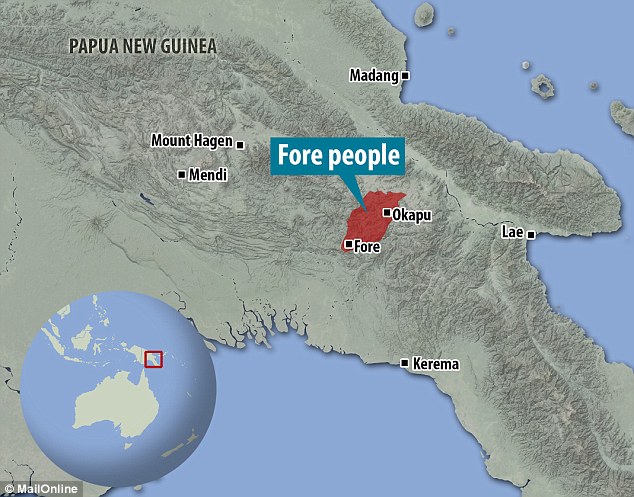10 July 2018
Brains for breakfast: Can cannibalism lead to disease resistance?
Posted by Shane Hanlon
This is part of a series of posts from our own Shane Hanlon’s disease ecology class that he’s currently teaching at the University of Pittsburgh Pymatuning Laboratory of Ecology. Students were asked to write popular science posts about (mostly) wildlife diseases. Check out all the posts here.
By Mackenzie Rodgers
The Fore tribe in Papua New Guinea has a long history of ritualistic cannibalism, resulting in a crippling outbreak of a degenerative brain disease called Kuru in the 1950’s. The epidemic devestated the tribe, but some survivors of the Kuru epidemic are now found to show signs of evolved Kuru resistance and possibly other degenerative neurological diseases.

Until the 1950s the Fore people, who reside in the Okapa District of the Eastern Highlands Province in Papua New Guinea (shown), had little contact with the outside world. Their discovery, though, may have important implications for tackling certain neurological diseases Credit: Daily Mail
After observing the tribe, scientists linked the disease to ritualistic cannibalism. In these rituals, the Fore people expressed respect by consuming dead family members. The men ate the flesh, while the women and children ate the brains. Since more women and children were contracting the disease, the transmission of Kuru was linked to ingestion of prions found in infected brain tissue.
Prions are naturally manufactured in all mammals, but in prion diseases, there is an accumulation of an abnormal proteins (PrP). The abnormal PrPs act like a virus and gradually attack brain tissue. The first symptoms of Kuru are usually tremors, difficulty balancing, and slurred speech, followed by mood changes. Affected people eventually deteriorate until they are unable to stand or eat. Most die within six months to a year following the first signs of disease. Prions have also been linked to mad cow disease, Creutzfeldt-Jakob disease (CJD), and a form of fatal insomnia.

People of the Fore tribe gathered for a ritual. Credit: Invisiverse – Wonder How To
When researchers began to look into the pattern of Kuru in the Fore tribe, they realized some families at the very center of the Kuru epidemic never developed this disease. Some hypothesized that genetic changes may have led to the resistance seen in some Fore people.
Researchers found that the Kuru-resistant Fore people carried an amino acid change in the prion protein gene. The amino acid valine was found in place of the glycine amino acid found in humans and every other vertebrate animal in the world. The Kuru epidemic promoted selection for a genetic change that led to protection against the disease – human evolution in action!
Genetically engineered mice with same genetic change were used to further test the previous observations. The results showed the genetically altered mice were resistant to all human prion strains, including Kuru and Creutzfeldt-Jakob disease.
The Fore people no longer practice cannibalism and I do not advise taking up a cannibalistic diet for the health benefits, but we can learn a lot from their unique situation. Continued research is looking to apply this information to other degenerative neurological diseases that millions around the world are affected by, such as dementia and Alzheimer’s.
Sources:
- https://www.ancient-origins.net/diet-human-brains-helped-papua-new-guinea-tribe-resist-disease-003233
- https://nationalpost.com/news/world/years-of-eating-human-brains-protected-papua-new-guinea-tribe-from-diseases-including-dementia-mad-cow
- https://www.telegraph.co.uk/news/science/11666536/Eating-brains-contributed-to-Papua-New-Guinea-tribe-resist-disease-research-shows.html
- https://invisiverse.wonderhowto.com/news/new-study-unveils-true-story-kuru-fatal-brain-disease-spread-by-cultural-practice-eating-dead-0175981/










 The Plainspoken Scientist is the science communication blog of AGU’s Sharing Science program. With this blog, we wish to showcase creative and effective science communication via multiple mediums and modes.
The Plainspoken Scientist is the science communication blog of AGU’s Sharing Science program. With this blog, we wish to showcase creative and effective science communication via multiple mediums and modes.